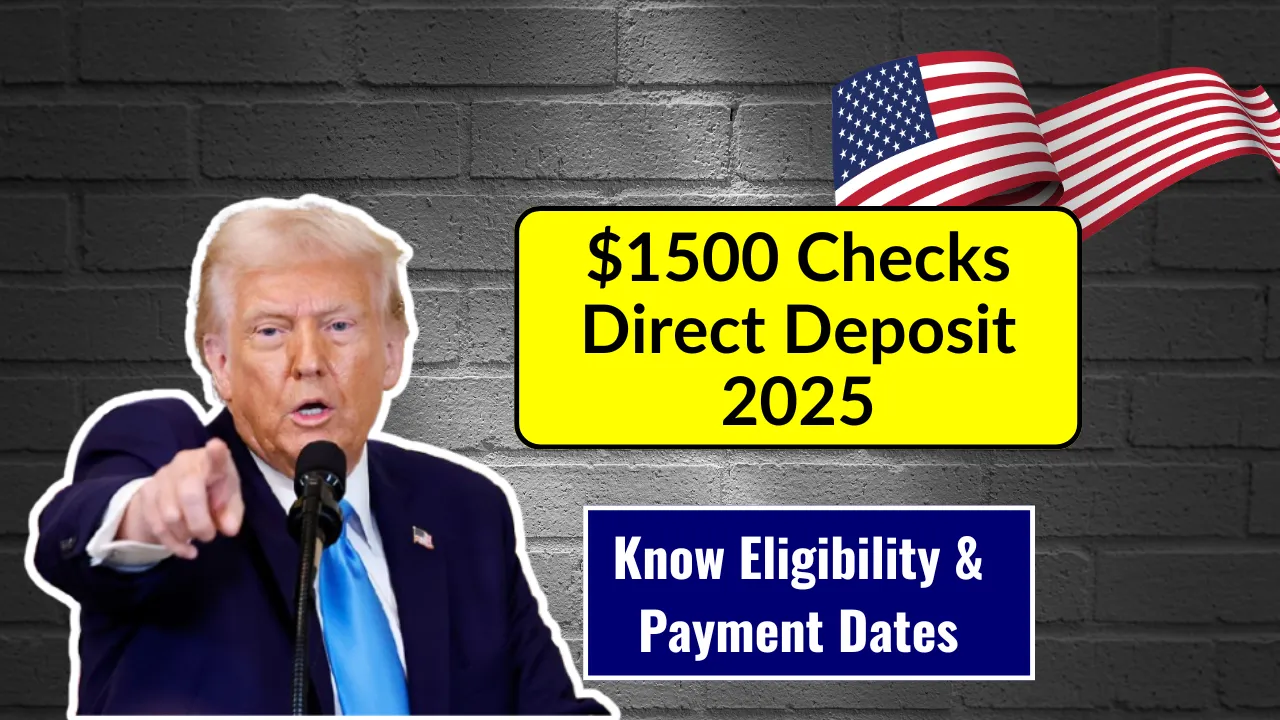$1450 Direct Deposit Coming in 2025: The talk around the $1450 direct deposit in 2025 has caused confusion and curiosity among many Americans. Is it a new stimulus check? Is it tied to social security? Or is it something else entirely? In a time where financial uncertainty remains high, it’s important to separate fact from fiction and understand what this payment really is, who qualifies for it, and what deadlines are involved.
Contrary to some assumptions, the $1450 direct deposit is not a brand-new government stimulus program. It’s largely connected to unclaimed Recovery Rebate Credits from 2021 and, for some, increased Social Security Income due to the 2025 cost-of-living adjustment. In this article, we’ll explain exactly what’s happening, how to verify your eligibility, when you can expect payment, and what steps you need to take before it’s too late.
$1450 Direct Deposit: Who Qualifies and What You Need to Know
The $1450 direct deposit refers to two separate financial developments happening in 2025. The main source is the IRS distribution of unclaimed Recovery Rebate Credits from 2021, which can amount to up to $1,400 per person. The second, which applies to Supplemental Security Income (SSI) recipients, involves a 2.5% cost-of-living increase, pushing monthly payments close to $1,450 for some. These are not new stimulus checks, but existing benefits or tax credits being finalized or adjusted.
Overview Table: $1450 Direct Deposit Details
| Payment Type | Amount | Who Qualifies | Deadline/Action Needed |
| Recovery Rebate Credit (IRS) | Up to $1,400 | People who didn’t file 2021 taxes or missed the credit | Must file 2021 return by April 15, 2025 |
| SSI Cost-of-Living Adjustment (COLA) | Approx. $1,450/month | Low-income elderly/disabled individuals on SSI | No action needed if already enrolled |
| Payment Method | Direct deposit | Based on benefit eligibility or tax records | Ensure bank account info is updated |
| Where to Check | IRS or SSA websites | IRS.gov or SSA.gov portals | Use official sites only to avoid scams |
The Truth About the $1450 Payment: Recovery Rebate Credits Explained
The majority of those receiving a $1450 direct deposit this year are actually getting their 2021 Recovery Rebate Credit—a refund of unclaimed COVID-19 stimulus money. According to the IRS, around one million taxpayers never claimed their 2021 stimulus payments. If you were eligible back then but didn’t file a tax return, you may still receive it—but only if you file your 2021 taxes before April 15, 2025.
This rebate was intended as a final round of economic relief from the pandemic, and if you missed it, you must act now. After the April deadline, any unclaimed funds will be permanently lost.
Critical April 2025 Deadline: Last Chance for Claims
Time is running out. Tax experts stress the importance of meeting the April 15, 2025 deadline. If you believe you’re eligible but haven’t filed a 2021 tax return, do it as soon as possible. If you’re unsure, it’s better to file and check than to miss out entirely. After this date, the IRS will no longer process Recovery Rebate Credit claims for 2021.
Those who qualify won’t need to request a separate payment. Once your return is accepted and eligibility confirmed, the IRS will issue the payment automatically via direct deposit or mail.
SSI Benefits vs. Stimulus: Understanding the Difference
Some confusion arises because of changes to Supplemental Security Income (SSI). The 2.5% Cost-of-Living Adjustment (COLA) for 2025 increased monthly SSI benefits. For some individuals, this raises their monthly payments to around $1,450, but this is not a stimulus payment.
It’s an adjustment based on inflation and is applied to regular benefits. If you’re an SSI recipient, this change would have taken effect at the beginning of the year, and you don’t need to do anything to receive it. The two payments—Recovery Rebate Credit and COLA-adjusted SSI—are entirely separate.
How to Verify Your Eligibility and Payment Status
If you’re wondering whether you qualify for the $1450 direct deposit, follow these steps:
- Create or log into your IRS online account at IRS.gov.
- Check the “Tax Records” section for details on past payments or credits.
- If you didn’t file taxes for 2021, submit your return immediately to claim the Recovery Rebate.
- Ensure your bank account details are correct so the deposit isn’t delayed or rejected.
- Be cautious: don’t share personal information via email or social media. The IRS never contacts people by text or phone asking for sensitive data.
Protection Strategies Against Financial Misinformation
With social media full of misleading headlines, misinformation about benefits is everywhere. To protect yourself:
- Rely only on trusted sources like IRS.gov or SSA.gov.
- Ignore unofficial websites or posts claiming “inside knowledge” of new government payments.
- Don’t pay any fees to access this payment—filing your taxes or checking your SSI info should always be free.
- Be skeptical of emails or calls asking for your Social Security number or banking details.
Financial scams often increase during periods of public interest in government programs. Stay alert.
Alternative Financial Assistance Programs Available Now
Even if the $1450 direct deposit doesn’t apply to you, other programs might:
- Supplemental Security Income (SSI): Monthly payments for low-income seniors or disabled individuals.
- SNAP (Food Stamps): Grocery assistance for qualifying families and individuals.
- Temporary Assistance for Needy Families (TANF): Support for families facing short-term hardship.
- State and Local Relief Programs: Many states offer rent aid, utility support, or food subsidies.
You can check your eligibility for these programs through your state’s human services website or local government offices.
Looking Ahead: Separating Fact from Fiction About the $1450 Direct Deposit
While the term $1450 direct deposit may suggest a new round of stimulus money, that’s not the case. This payment is either part of an old tax credit being claimed now or an adjustment to ongoing SSI benefits. Either way, it’s important to act based on facts—not rumors.
The best thing you can do is:
- Verify your status with the IRS if you believe you missed out on your 2021 stimulus credit.
- File your 2021 return before April 15, 2025, to claim it.
- Check your SSI benefit statements if you’re a current recipient.
- Explore other federal or state-level assistance programs you may be eligible for.
FAQs
Is the $1450 direct deposit a new stimulus check?
No, it’s either unclaimed COVID-19 Recovery Rebate Credits or adjusted SSI benefits—not a new stimulus program.
How do I know if I qualify for the Recovery Rebate Credit?
If you didn’t receive your full 2021 stimulus or didn’t file a return that year, you may qualify. File your taxes before April 15, 2025.
Do I need to apply for the SSI increase?
No. If you’re already receiving SSI, the 2.5% COLA increase is automatic.
Where will the payment be sent?
To the bank account or address linked to your IRS or SSA records. Make sure it’s up to date.
How can I avoid scams?
Use official websites like IRS.gov and never share personal information over phone, text, or email from unknown sources.
Final Thought
The $1450 direct deposit in 2025 may not be what social media makes it out to be, but for many, it’s a valuable source of relief—whether from tax credits or benefit increases. The key is knowing where you stand, taking timely action, and staying informed through official channels.
If you’re eligible, don’t miss the April 15 deadline. Share this information with others who might benefit, and explore other support programs that could provide even more assistance in these financially uncertain times.







